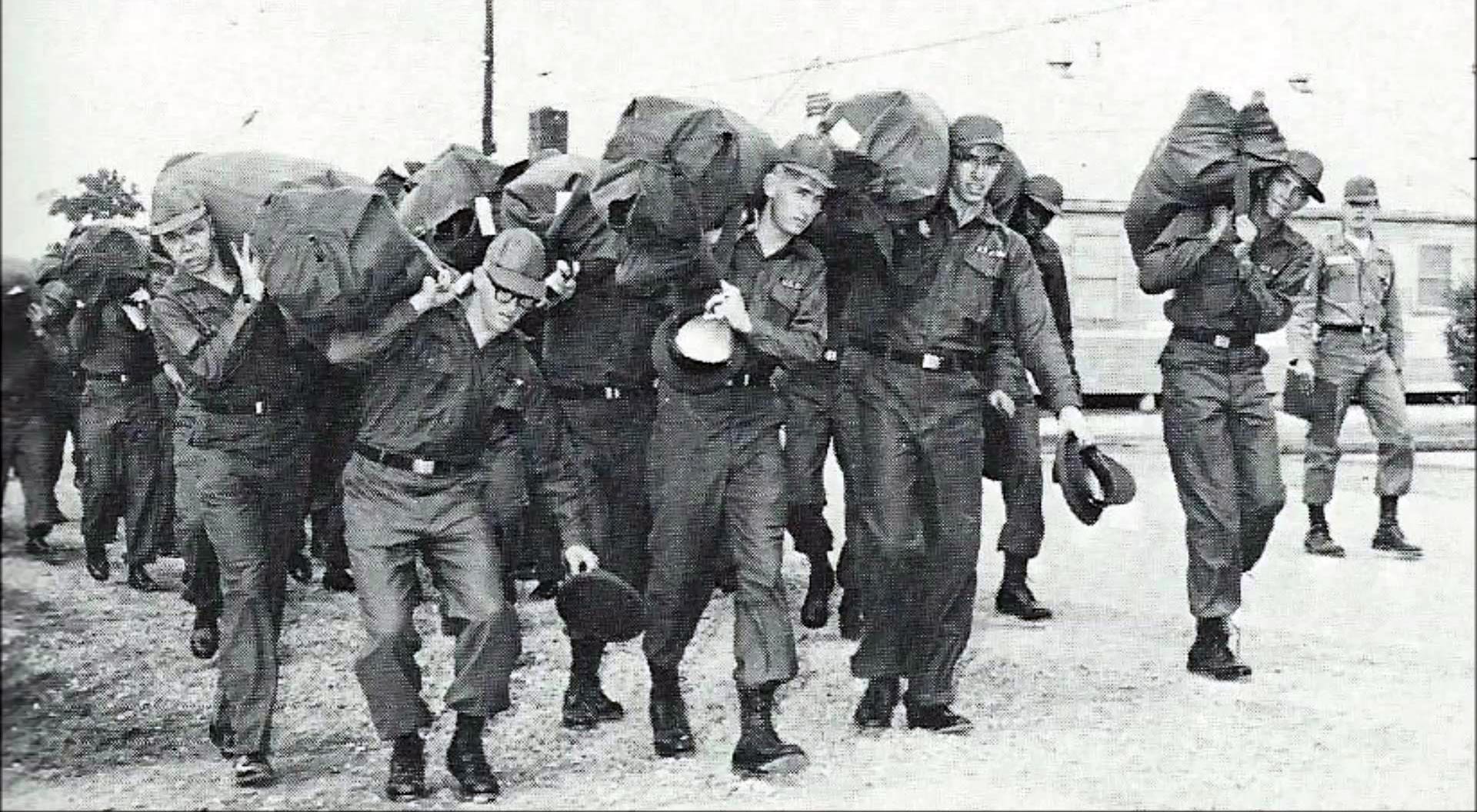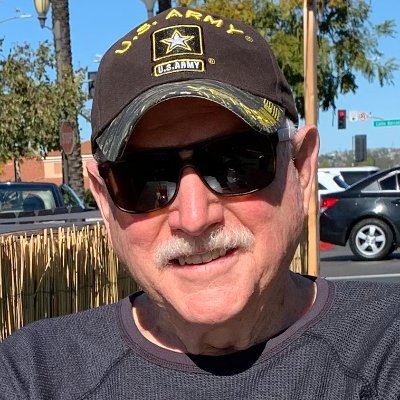Unlike Gen. Arbuckle, author of the following commentary, I went through basic training for the U.S. Army at Ft. Leonard Wood, Missouri. I was assigned to E Company, 3rd Battalion, 2nd Training Regiment, or E-3-2. It was October 8, 1962, and we ended basic training on November 29, 1962. It was 8 weeks of fierce training, including a range of activities such as dismounted drill, physical fitness, hand-to-hand combat, rifle instruction and trainfire, land navigation, target detection, bayonet training, bivouac, hand grenades, and close combat training.
Like Gen. Arbuckle, I and several dozen other recruits arrived at night by bus, and we were rousted from the vehicle by a couple of drill instructors screaming commands. We were marched straight to the quartermaster warehouse, where we were issued a large duffle bag and an assortment of clothing, shoes, hats, boots, and other gear.

“Everything goes into the duffle bag, you dickheads,” a staff sergeant yelled. After stuffing everything into the duffle bags, we put them on our shoulders and marched to our billets in the Easy Company compound. The duffle bags must have weighed 70 or 80 pounds, and a few recruits could not lift them to their shoulders, so they made the mistake of dragging them. “Get that duffle bag off the ground, numbnuts,” Staff Sergeant Harrington yelled at one recruit. “Don’t ever let me see you dragging that bag again.”
Somehow, we made it to the E-3-2 compound, and from that point on, our experiences mirrored those Gen. Arbuckle relates in his commentary.
As General Arbuckle points out, basic training is about assimilation. It is about taking the individual and making him (there were no “hers” in combat training in 1962) become part of a unit. Unit cohesion makes everything from a 10-man rifle squad to a field army function as seamlessly and efficiently as possible. As the general points out, DEI works against assimilation and cohesion, causing disunity and division in the military. That should concern us all because the military must operate without discord and with maximum unity and effectiveness to be successful.
Which Makes Better Soldiers: DEI or Assimilation?
By Maj. Gen. Joe Arbuckle (USA, Ret.)
Diversity, Equity, and Inclusion (DEI) is divisive, as it emphasizes differences based on race, ethnicity, biological sex, gender identities, etc., as opposed to the time-tested, traditional military culture, which emphasizes unity, teamwork, selflessness, sacrifice, and assimilation into the warrior ethos.
In May 1969, a commercial bus full of sleepy recruits stopped during darkness at Fort Ord, CA. Two Drill Instructors (DIs) jumped on the bus, screaming, “Get off my bus, you dirtbags, and line up outside.” A diverse assortment of now wide-awake young men lined up in four rows and then shuffled/marched to sterile appearing billets with a platoon of 50 recruits in each open bay, gray double-decker bunks with sheets and a wool blanket on both sides of an aisle running down the middle of the bay. They were awake until 0200, scrubbing the billet floors and latrine, up at 0530 the next day.
The next day, with DIs yelling commands, they marched to the long quartermaster warehouse to be issued clothing and gear. But, first, a stop at the barber building with a line of barbers ready to buzz hair off, which they did quickly, leaving about 1/4 inch on the top and almost none elsewhere.
Inside the quartermaster building was a long countertop with mostly civilians on the opposite side manning issue stations; the recruits moved from one station to the other, getting standard Olive Drab issue clothes, which they stuffed into duffle bags. Sizes for fatigues, socks, t-shirts, boots, etc. were based on the calibrated eyeball estimate of the QM guy behind the counter. The heavy duffle bags were carried back to the billets where the contents were arranged in foot and wall lockers, dress right dress, according to the SOP, inspected and enforced by the DIs.
All of this was done to erase the “back on the block” civilian mentality and quickly replace it with “you’re in the Army now” and don’t forget it mindset. No more personal identities, no more it’s about me, it is now about the “Green Machine, your ass is mine,” and your personal identity as a civilian does not matter; it no longer exists — you are now part of the machine — you have one color — Green.

Basic training was all about “Assimilation” and “Inclusion” into the military; a trainee’s “Diversity” did not matter. What mattered was giving up their past identity and becoming a part of the team—the Green Machine. Everyone was included regardless of race or ethnicity.
Assimilation into the team grew with shared hardships, further motivated by group punishment imposed by DIs; when a trainee screwed up, normally everyone paid a price. Everyone dropped for 25, everyone ran extra distance, and everyone was up until midnight cleaning the latrine — that is applied “Assimilation.”
After a few weeks, real bonding developed to the point when a trainee started to fall out of a run; others would automatically drop back and pull him along to the finish. The camaraderie was developing according to the DI’s plan.
The DI’s objective was to break down trainees by suppressing their past identities and molding them into soldiers, believing in a common set of values, mission, and purpose. It was about removing the focus on “self” and putting the focus on selfless service with loyalty to each other and the mission; that was done by sharing challenging physical and mental hardships in Infantry Basic Training. The physical training (PT) was tough, as it served two purposes: one was to build the necessary physical strength and stamina to survive in combat, and the other was to bond the team by creating mutual trust and confidence in each other’s physical abilities and motivation to succeed.
One of the seven PT test events was the 150-yard man-carry, where a trainee of equal weight would hoist another and run 150 yards, a timed event. This simulated carrying a fallen comrade under fire to safety, and no one wanted to fail the test and let their buddy down. When approaching the end of eight weeks, some trainees had painful stress fractures in their feet due to the man-carry, but they refused to be medically recycled; they were determined to graduate from Infantry Basic Training on time with their platoon.
Today 68% of our military is overweight and/or obese. How many of them could hoist someone of equal weight and run 150 yards carrying a battle buddy to safety? How can one soldier trust another, recognizing this reality? This sad state of physical condition is representative of low standards of performance and readiness coming from DEI.
The bonding in basic training was reinforced by the reality frequently emphasized by the DIs, saying, “Within a year, 90% of you will be fighting in Vietnam.” The point was driven home by the DIs further saying, “You had better pay attention to this, or you’ll get your ass shot off, or worse yet, your buddy’s.”
This assimilation model had been battle-tested for centuries long before America came along and proven to work when civilians from diverse backgrounds are successfully assimilated into a homogeneous fighting force, leaving their “back on the block” identity behind. Conversely, DEI is divisive by focusing on “self” and self-identity as a member of an identity group based on race, ethnicity, gender, etc. This is the opposite of the DI battle-tested model of team building and unit cohesion based on a common mission, selfless service, and sacrifice.
Contrary to the DEI slogan, “Diversity is Our Strength,” the historical truth and battle-tested reality are: “Unity and Assimilation are Our Strengths.”
Maj. General Joe Arbuckle, USA (Ret.) graduated from college in 1968 and entered the Army in 1969 as a private. Following training as a combat engineer, he was commissioned upon graduating from Engineer Officer Candidate School in 1970. Having volunteered for duty as an Infantry Officer, he served a year in Vietnam on Advisory Team 22, embedded with the South Vietnamese Army. He has commanded at every rank from Lieutenant to Major General, specializing in the missile field.
–30–
If you enjoyed this post, please consider subscribing to ForeignCorrespondent and tell your friends to subscribe. IT’S FREE! WHAT A DEAL! If you’ve received this from a friend and would like to be added to our distribution list for future blog posts, please enter your email address in the sign-up in the notifications box at:
https://ronaldyatesbooks.com/category/foreign-correspondent.
You can also find my commentaries on Substack at https://ronyates.substack.com/ and the American Free News Network at https://afnn.us.
Please feel free to comment. WE LOVE COMMENTS!


This is so on target!! Our soldiers deserve better than DEI. Thank you for your service!